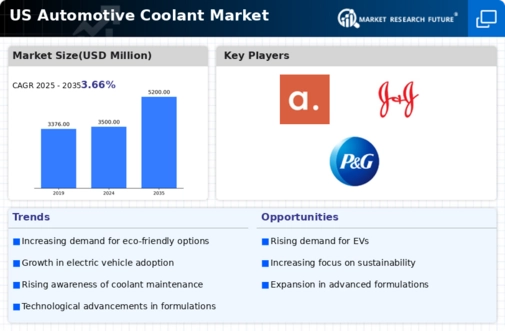The automotive coolant market is characterized by a competitive landscape that is increasingly shaped by innovation, sustainability, and strategic partnerships. Key players such as Valvoline (US), Prestone (US), and Shell (GB) are actively pursuing strategies that emphasize product differentiation and technological advancements. Valvoline (US), for instance, has focused on enhancing its product line with eco-friendly formulations, which aligns with the growing consumer demand for sustainable automotive solutions. Meanwhile, Prestone (US) has been investing in digital marketing initiatives to strengthen its brand presence and engage with a tech-savvy customer base. Shell (GB) appears to be leveraging its extensive distribution network to expand its market reach, thereby enhancing its competitive positioning in the sector.
The market structure is moderately fragmented, with several players vying for market share through localized manufacturing and optimized supply chains. This fragmentation allows for a diverse range of products, catering to various consumer preferences and regional requirements. Companies are increasingly localizing their manufacturing processes to reduce lead times and enhance responsiveness to market demands. The collective influence of these key players fosters a dynamic environment where innovation and operational efficiency are paramount.
In November 2025, Valvoline (US) announced the launch of a new line of biodegradable coolants, which is expected to capture the attention of environmentally conscious consumers. This strategic move not only positions Valvoline (US) as a leader in sustainable automotive solutions but also reflects a broader industry trend towards eco-friendly products. The introduction of biodegradable options may potentially reshape consumer expectations and drive competitors to innovate in similar directions.
In October 2025, Prestone (US) unveiled a partnership with a leading automotive technology firm to develop smart coolant monitoring systems. This initiative aims to integrate IoT technology into coolant management, allowing users to monitor coolant levels and performance in real-time. Such advancements could significantly enhance customer experience and operational efficiency, indicating a shift towards more technologically integrated automotive solutions.
In September 2025, Shell (GB) expanded its product offerings by acquiring a niche coolant manufacturer specializing in high-performance formulations. This acquisition not only diversifies Shell's product portfolio but also strengthens its position in the premium segment of the market. The strategic importance of this move lies in Shell's ability to leverage its existing distribution channels to promote these high-performance products, thereby enhancing its competitive edge.
As of December 2025, the automotive coolant market is witnessing trends that emphasize digitalization, sustainability, and the integration of advanced technologies such as AI. Strategic alliances are increasingly shaping the competitive landscape, enabling companies to pool resources and expertise to drive innovation. The shift from price-based competition to a focus on technological differentiation and supply chain reliability is becoming evident. Companies that prioritize innovation and sustainability are likely to emerge as leaders in this evolving market.














Leave a Comment